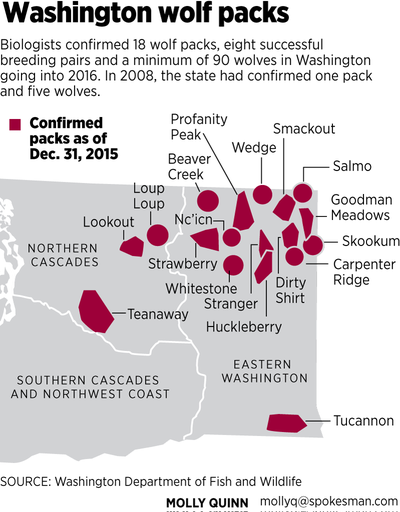Washington wolves serve as random attraction

Wolves have a legion of admirers willing to spend money to hear the charismatic carnivores howl and see them run and hunt.
However, that doesn’t mean the steady growth of wolf populations will offer an economic boost in Washington.
Studies have documented the millions of dollars spent on books, calendars, DVDs, T-shirts, guide services, spotting scopes and all the travel expenses wolf fans cover while coming and going through Yellowstone National Park.
University of Montana researchers found the boost wolves have given the Yellowstone region’s economy more than offsets losses in the hunting and outfitting sector caused by the reductions in the wolves’ prey, primarily elk.
So far, there’s little evidence that wolves will be a similar financial stimulus in Washington, where the wolf population has been growing about 36 percent a year since the first pack in 70 years was confirmed in 2008.
Last week, the state Department of Fish and Wildlife reported that Washington’s wolf population added at least four new packs last year, bringing the population to a minimum of 90 wolves in at least 18 packs.
The agency has been spending more than $1 million a year on monitoring wolves, responding to conflicts with pets and livestock and organizing range rider and other programs to prevent wolf attacks on livestock.
Fish and Wildlife officials are mainly focused on fulfilling the recovery objectives of the state’s Wolf Management Plan, said Donny Martorello, head of the agency’s wolf program.
While some state residents wish wolves had never been allowed to move back into the state, he said it’s clear that other people are thrilled at the prospect of seeing one.
“We get a lot of reports on wolf sighting, so the opportunity is there,” he said. “Most of them are random sightings, but some people have captured the moment with some really nice photographs.”
Martorello said he’s not sure Washington will have wolf viewing opportunities that comes close to rivaling Yellowstone’s Lamar Valley.
“The Yellowstone landscape has concentrated big game herds and more openness,” he said, noting that the best wolf country in Washington is more timbered.
“The big difference is the amount of human disturbance. Yellowstone has very few roads and the wildlife are not disturbed so much. The game has more room to roam. Deer and elk aren’t nearly as skittish as they are outside the park. The park wolves are less elusive and secretive.”
Interest in hearing and seeing wolves will continue to grow as Washington’s wolves expand, Martorello said.
Some conflicts wolves generate among hunting and ranching groups also will continue, he acknowledged.
Few conflicts and consistent viewing opportunities are goals that Washingtonians can only dream about at this point, he said.
“That’s something special about our national parks,” he said.